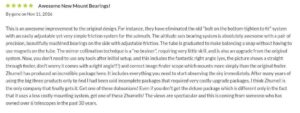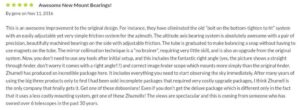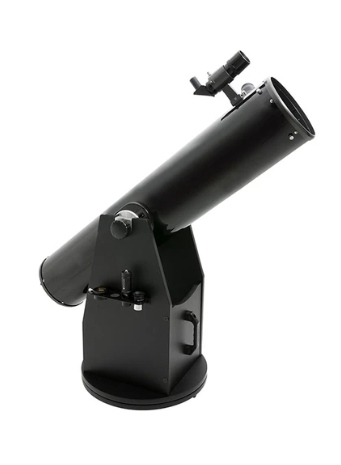*This post may contain affiliate links. This means we may make a commission if you purchase an item using one of our links*
If you’ve found yourself on this review, there’s a good chance that you’re someone who’s either looking to upgrade their small telescope setup to a device a lot more capable or maybe you’re looking to gift the system to someone else.
If any of these apply to you, within this Zhumell Z8 review I’ll try to help you out in making a decision on the system, outlining the good, bad and other features that may make it worth investing $600+ for the device.
Overview
Table of Contents
- Full Name: Zhumell Z8
- Type: Dobsonian Reflector
- Aperture: 8″ (203 mm)
- Focal length: 1200mm
- Focal ratio: f/5.9
- Weight & Dimensions: 15kg and 48.3 x 48.3 x 129.5 cm
- Included eyepieces: 2″ 30mm and 1.25″ 9mm
- Rating: 4.6/5
Pros
- Great Power For The Price
- High Quality Dobsonian Mount
- High quality dual speed focuser
- Solid eyepieces included
Cons
- Open Tube Means Higher Maintenance
- It’s Somewhat Heavy
- SUPERIOR OPTICS: The Zhumell Z8 features high-quality, coated glass optics that gathers a substantial amount of light and produces crisp, bright images.
- STURDY DOBSONIAN BASE: The durable Dobsonian base will stand up to years of use from public star parties to camping trips and beyond. Use the integrated carry handle for easy transport.
- 8” PRIMARY MIRROR: Our Newtonian reflector telescope is equipped with a large, 8-inch primary mirror for stunning views of planets, galaxies, nebulae, and more.
- BUILT-IN COOLING FAN: Cool the primary mirror to the ambient outdoor temperature faster so you can enjoy the sharpest views sooner.
- ACCESSORIES INCLUDED: This telescope kit comes complete with a 2” 30mm eyepiece for wide-field views, a 1.25” 9mm eyepiece for higher magnification, a 2” focuser with 1.25” adapter so you can use a variety of astronomical eyepieces, a 8x50 right angle finderscope, a 1.25” Moon filter, a collimator cap, and more.
What Does The Zhumell Being A Reflector Mean?
If you’re unfamiliar with the different lens structures of a telescope, there are actually 3. These three include a refractor system, a compound system and of course a reflector system.
Reflector Lens
All of the lens designs have their own benefits and weakness and I’ve gone over it in a lot more detail in this article however, all you really need to know are the main strengths of a reflector as this is the design the Z8 uses, which in this case include the following elements :
- They don’t suffer from chromatic aberration
- They’re great for viewing faint objects as all types of light can pass through the lenses
- A reflector is also cheaper than the other designs meaning you can get a larger scope for less money.
Of course such a system also has a few cons. These cons also apply to the Zhumell Z8 and include the following :
- As the optics are exposed you will need to maintain it more
- You’ll need to realign the lenses very regularly
- You’ll see diffraction on bright objects.
What Do Zhumell Z8’s Specifications Mean
The systems aperture is 203mm with a focal length of 1200mm resulting in a focal ratio of f/5.9
This means the Zhumell Z8 is a reasonably fast telescope and will be more than capable at viewing both galaxies and planets. This is because theoretically the magnification of the Z8 can reach a really high 400x, provided you buy a strong enough eyepiece or barlow lens.
The device will in turn all you to make out planets like Jupiter, Venus at pretty solid detail, see Saturn’s ring in pretty solid detail and of course the larger star clusters, nebulae and galaxies should also be visible via the telescope.
After all the 8 inch aperture is much stronger than weaker scopes and is more designed for intermediate astronomers so having it be at least this capable does make sense.
The Dobsonian Mount
Another one of its more advertised feature is the Dobsonian style mount that it uses.
Instead of using the lesser bearing system used on other devices such as plastic on Teflon with tension adjustment via springs, the Zhumell Z8’s bearings are ball bearings which can be adjusted for tension, and can slide along the tube for balancing.
This means that the Z8’s mount is able to balance much heavier eyepieces in excess of 1.5kg without falling over.
Moreover, the azimuth bearing is also much improved as it uses a roller design over the typical Teflon laminate. This means shifting the device from side to side will be pretty smooth although it does seem as if it’s a design that will need some getting used to.
Do note that you’ll be given an Allen key (used for collimation) and will need to put the scope together once you get it out of the box which may take 30 minutes plus, depending on how proficient you are at putting things together.
All In all, the Dobsonian mount found on the Zhumell Z8 is among the better ones at its price range therefore, this may be one reason to pick the Z8 up.
The Accessories Included In The Box
The accessories included in the box are a 30mm wide angle eyepiece and another much narrower eyepiece at 9mm. The magnification for these eyepieces are at 40x and 133x respectively.
You’ll also get access to a dual-speed focuser with a micro-adjusting knob, a quality 9×50 finderscope, and even an included laser collimator.
The two stand out accessories in my opinion and the opinion of many users of the system are the 2 inch 30mm eyepiece and the dual speed focuser.
The 2 inch eyepiece is a good wide angle lower power device, which makes it great for observing the wider expanse of outer space, quite easily in fact with its 70 degree apparent field of view.
The 9mm eyepiece is decent too for an inbox accessory but, it’s views are significantly narrower with a 45 degree apparent field of view.
In short they’re actually solid inbox eyepieces but, in the future if you’re seeking more quality, it will be worth looking into other ones as plossls as a whole are mediocre in the grand scheme of things (check this list out for a couple eyepieces to look into).
Now the dual speed Crayford focuser is genuinely a really good item considering it comes in the box. The focuser acts like any other crayford focuser where the focuser rolls the drawtube against 4 rollers for precision and smooth motion. The dual-speed part comes from it having a 1:10 fine adjustment knob for allowing for precision focusing on higher magnifications.
So, the focuser is just a great addition as it allows for a precise viewing experience.
What Are The Experiences Of Other Users
Simply put the majority of individuals who’ve purchased the device have found it to be great. On telescopeplus the reviews are mostly positive with the only real issue being its weight and size but, that’s to be expected considering the size of its aperture afterall.


Overall, users of the device have found it to essentially be the complete package, unlike a Celestron, meade or orion that tend to always supply an incomplete package.
Other Alternative Telescopes
There are many other options you could look into if you’re not quite content with the Z8. For example if you’re budget is not too high, check this list out or if you’re more interested in astrophotography, maybe one of these telescopes I’ve listed may be to your liking.
Summary
All in all the Zhumell Z8 is a genuinely good Dobsonian reflector and is a system that the more intermediate or even beginner level astronomers should look into and as long as you don’t mind regularly maintaining it and understand how to use software to view any particular celestial objects you want to view, it’ll be great for you.
Of course being an 8 inch device does mean it won’t be great if you want travel with, particularly if you’re going abroad, but it’s a genuinely good system and one a lot telescope aficionados wouldn’t mind recommending, including myself.
==>Click Here To Check The Zhumell Z8’s Price On Amazon!
Hopefully this review as helped you out in making your decision!


